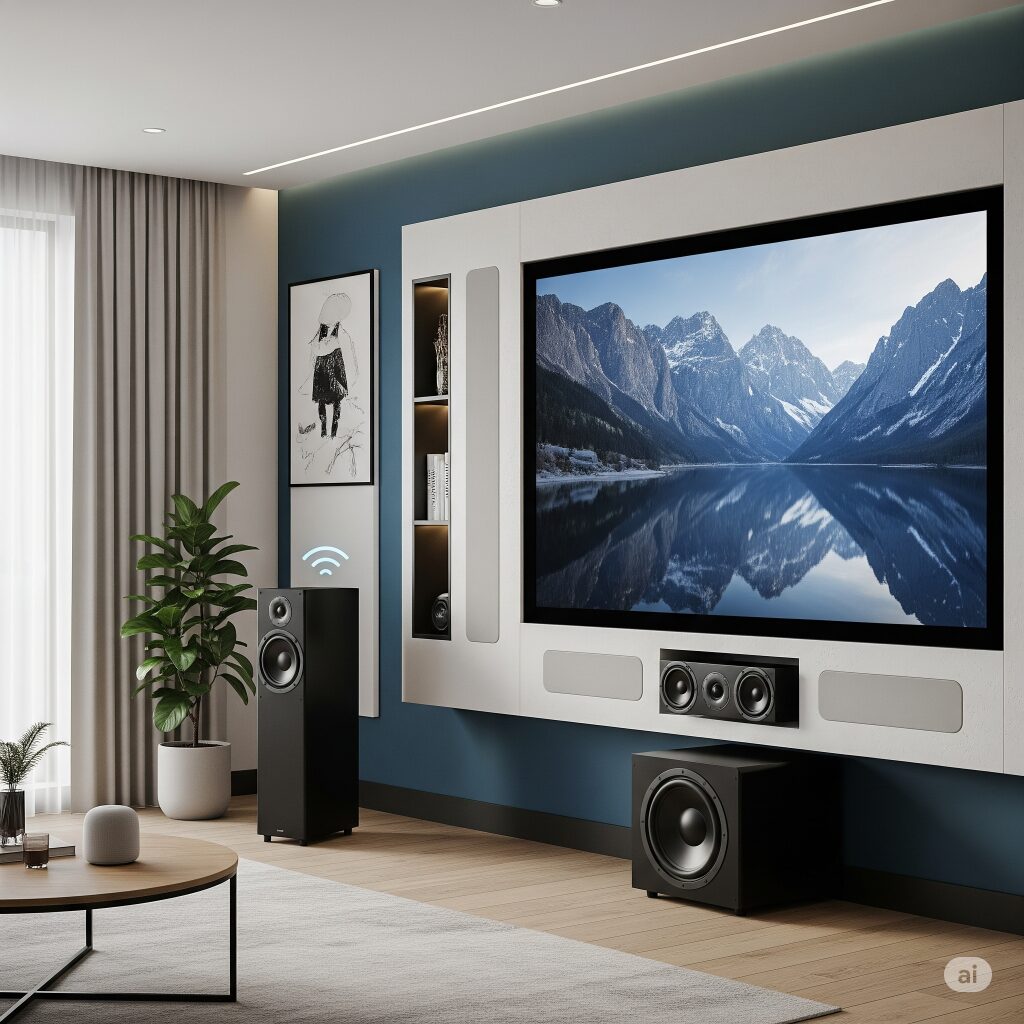The Symphony of the Connected Home: Entertainment Systems in a Smart Home Ecosystem
In an era where convenience, personalization, and seamless integration reign supreme, the concept of a “smart home” has transcended mere automated lighting and thermostats.
Today, a truly intelligent dwelling orchestrates every aspect of daily life, and entertainment systems stand at the forefront of this evolution.
From voice-controlled smart speakers and displays to immersive home theaters and pervasive multi-room audio, smart home technology is transforming how we consume and interact with our favorite content.
The Rise of Smart Speakers and Displays: More Than Just Sound
Smart speakers and displays have rapidly become the unassuming conductors of the smart home orchestra.
More than just devices for playing music or podcasts, they serve as central hubs for controlling a myriad of connected devices and accessing a wealth of information.
Key Features and Benefits:
- Voice Control: The most defining feature, allowing hands-free operation for music playback, volume adjustment, information retrieval, setting alarms, and controlling other smart home devices like lights and thermostats. Popular assistants include Amazon Alexa, Google Assistant, and Apple’s Siri.
- Integrated Virtual Assistants: Beyond basic commands, these assistants offer conversational interfaces, allowing for more natural interactions and the ability to understand complex requests.
- Smart Home Hub Functionality: Many smart speakers, particularly smart displays, act as central control panels. They can connect to and manage devices using various protocols (Wi-Fi, Bluetooth, Zigbee, Z-Wave, and increasingly, Matter), bridging communication gaps between different brands and ecosystems.
- Enhanced Audio Quality: While early smart speakers prioritized voice interaction, newer models, like the Sonos Era series or Amazon Echo Studio, offer significant improvements in sound fidelity, often with spatial audio capabilities, making them viable for serious music listening.
- Visual Interaction (Smart Displays): Devices like the Amazon Echo Show and Google Nest Hub integrate touchscreens, providing visual feedback for voice commands, displaying recipes, video calls, security camera feeds, and acting as digital photo frames.
- Multi-room Audio Grouping: A cornerstone of smart home entertainment, allowing users to synchronize music across multiple speakers in different rooms or play different audio in various zones, all controlled from a single app or voice command.
- Streaming Service Integration: Direct access to popular music and video streaming platforms (Spotify, Apple Music, Netflix, YouTube, etc.) eliminates the need for additional devices.
Impact on Smart Home Applications:
Smart speakers and displays are not just entertainment devices; they are integral to the daily flow of a smart home.
Imagine waking up to your favorite playlist, which then follows you from the bedroom to the kitchen as you make coffee.
A simple voice command can dim the lights and start a movie on your smart TV, all without lifting a finger.
Their ability to serve as a voice-activated interface for the entire smart home elevates convenience and accessibility.
Home Theaters: The Immersive Core of Smart Entertainment
The traditional home theater has been revolutionized by smart technology, moving beyond a collection of disparate components to a cohesive, integrated cinematic experience.
Integration into the Smart Home:
- Centralized Control: A smart home hub or dedicated home theater controller (e.g., Control4, Savant) can unify the control of your projector or smart TV, AV receiver, speakers, lighting, motorized blinds, and even climate control, all from a single interface or voice command.
- Automated Scenes and Routines: Create “Movie Night” scenes that automatically dim lights, lower projector screens, power on the AV receiver and projector, and adjust the thermostat for optimal comfort. “Gaming Mode” could adjust lighting for minimal glare and optimize audio settings.
- Voice-Activated Operation: “Alexa, turn on the home theater” can initiate a complex sequence of actions, preparing your viewing space without manual adjustments.
- High-Quality Audio and Visuals: Smart home theaters leverage advanced technologies like 4K and 8K HDR displays, immersive surround sound formats such as Dolby Atmos and DTS:X, and high-fidelity speakers (including in-wall and in-ceiling options for a discreet aesthetic).
- Seamless Content Access: Smart TVs and integrated streaming devices provide instant access to a vast library of movies, TV shows, and sports, often with voice search capabilities.
Benefits of a Smart Home Theater:
The integration of a home theater into a smart home system elevates the user experience significantly.
It transforms a simple viewing room into a dynamic, intelligent environment that adapts to your preferences, creating unparalleled immersion and convenience.
The elimination of multiple remotes and the ability to control everything intuitively are major advantages.
Multi-Room Audio: Music Without Boundaries
Multi-room audio systems extend the entertainment experience beyond a single room, filling the entire home with synchronized sound or allowing individual zones to play different content.
Key Components and Integration:
- Networked Speakers: Wireless speakers (e.g., Sonos, Denon Home, Bose Smart Speakers) connect over Wi-Fi, allowing for seamless audio distribution.
- Audio Distribution Amplifiers: For wired multi-room setups, these amplifiers power speakers in various zones, often hidden away in a central equipment rack, reducing clutter.
- Streaming Capabilities: Integrated streaming services and support for protocols like AirPlay 2 and Chromecast allow users to stream music from their favorite platforms to any or all rooms.
- Zone Control: Users can independently control the volume and content in each room or group rooms together for a synchronized listening experience (e.g., a “party mode”).
- Voice and App Control: Manage your entire multi-room audio system from a smartphone app or through voice commands via smart speakers.
- Invisible Integration: In-wall and in-ceiling speakers can be discreetly installed to blend with the home’s décor, providing high-fidelity sound without visual intrusion. Outdoor weatherproof speakers also extend entertainment to patios and gardens.
Best Practices for Implementation:
- Plan Ahead: If building or renovating, consider cabling for wired solutions, as this offers superior reliability and audio quality.
- Choose a Cohesive Ecosystem: Sticking with a single brand or platform (e.g., Sonos, Apple HomeKit, Google Home) can simplify setup and ensure better compatibility.
- Optimize Network Infrastructure: A robust Wi-Fi network is crucial for wireless multi-room audio to prevent dropouts and ensure smooth streaming. Consider mesh Wi-Fi systems for larger homes.
- Strategic Speaker Placement: Proper placement is essential for optimal sound dispersion and to avoid dead spots.
- Consider Acoustic Treatments: In dedicated listening spaces, acoustic panels, carpets, and heavy curtains can significantly improve sound clarity and reduce echo.
The Future of Smart Home Entertainment
The evolution of smart home entertainment is ongoing, with exciting advancements on the horizon:
- Smarter, More Personal AI: Voice assistants will become even more conversational and predictive, anticipating user preferences and proactively adjusting settings (e.g., automatically dimming lights and queuing a playlist when you settle down for the evening).
- All-in-One Connectivity: The adoption of universal standards like Matter will further simplify device compatibility, allowing seamless integration of products from different manufacturers.
- Augmented and Virtual Reality Integration: While still emerging, AR and VR could offer truly immersive entertainment experiences, blurring the lines between the digital and physical worlds within the home.
- Dynamic and Adaptive Environments: AI-powered systems will automatically adjust audio, lighting, and display settings in real-time based on occupancy, user behavior, and even the content being consumed, creating a truly tailored experience.
- Sustainable Solutions: Greater emphasis will be placed on energy-efficient AV technologies and smart power management to reduce consumption without compromising on entertainment quality.
Challenges and Solutions
Despite the immense benefits, integrating smart home entertainment systems can present challenges:
- Compatibility Issues: Devices from different manufacturers may use disparate communication protocols.
- Solution: Research compatibility before purchasing, choose devices from the same ecosystem when possible, or invest in a central smart home hub that supports multiple protocols (e.g., Zigbee, Z-Wave, Matter).
- Internet Connectivity Problems: A weak or unstable Wi-Fi signal can lead to interruptions and unresponsiveness.
- Solution: Optimize router placement, upgrade to a modern router with broader coverage (e.g., Wi-Fi 6), consider a mesh Wi-Fi system for larger homes, and use wired connections where feasible for critical components.
- Complexity of Setup: Initial configuration of multiple devices and creating intricate routines can be daunting for some users.
- Solution: Utilize user-friendly apps, consult manufacturer guides, or consider professional installation for complex setups.
- Security and Privacy Concerns: Smart devices collect data, raising concerns about privacy and potential security vulnerabilities.
- Solution: Use strong, unique passwords, enable two-factor authentication, keep device firmware and apps updated, and be mindful of the data collected by devices.
- Cost: High-end smart home entertainment systems can be a significant investment.
- Solution: Start with smaller, modular systems and gradually expand as budget allows. Many entry-level smart speakers and displays offer excellent value.
In conclusion, entertainment systems are no longer standalone components but rather integral, intelligent elements within the smart home.
From the ubiquitous smart speaker acting as a voice-controlled concierge to the fully automated home theater that rivals commercial cinemas, and the seamless flow of multi-room audio, smart technology has unlocked a new era of personalized, convenient, and deeply immersive entertainment experiences.
As these technologies continue to evolve, the future promises even more intuitive and captivating ways to enjoy content within the comfort and control of our connected homes.


